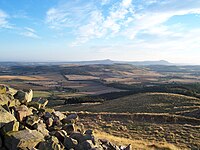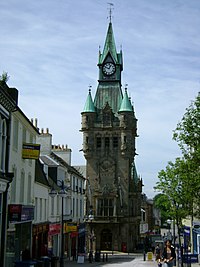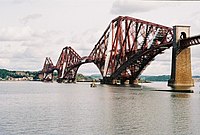Difference between revisions of "Fife"
m (→Parishes) |
(→Towns) |
||
| Line 60: | Line 60: | ||
*[[Crail]] | *[[Crail]] | ||
*[[Creich, Fife|Creich]] | *[[Creich, Fife|Creich]] | ||
| − | *[[Culross]] | + | *[[Culross]]<sup>*</sup> |
*[[Cults]] | *[[Cults]] | ||
*[[Cupar]] | *[[Cupar]] | ||
| Line 91: | Line 91: | ||
*[[Monimail]] | *[[Monimail]] | ||
*[[Moonzie]] | *[[Moonzie]] | ||
| − | *[[Newburgh]] | + | *[[Newburgh]] |
*[[Newburn, Fife|Newburn]] | *[[Newburn, Fife|Newburn]] | ||
*[[Pittenweem]] | *[[Pittenweem]] | ||
| Line 100: | Line 100: | ||
*[[Strathmiglo]] | *[[Strathmiglo]] | ||
*[[Torryburn]] | *[[Torryburn]] | ||
| − | *[[Tulliallan]] | + | *[[Tulliallan]]<sup>*</sup> |
*[[Wemyss]] | *[[Wemyss]] | ||
{{parishlistend}} | {{parishlistend}} | ||
| − | < | + | <sup>*</sup>: These parishes form a detached part of Perthshire, locally in Fife.<br /> |
Additionally the parish of [[Abernethy]], otherwise in Perthshire and that of [[Arngask]], otherwise in Kinross-shire and Perthshire extend into Fife. | Additionally the parish of [[Abernethy]], otherwise in Perthshire and that of [[Arngask]], otherwise in Kinross-shire and Perthshire extend into Fife. | ||
Latest revision as of 14:20, 6 May 2022
| Fife United Kingdom | |
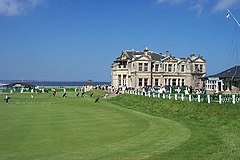 The Royal and Ancient Golf Club of St Andrews | |
|---|---|
| Virtute et opera (By virtue and by industry) | |
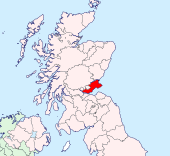
| |
| [Interactive map] | |
| Area: | 504 square miles |
| Population: | 365,493 |
| County town: | Cupar |
| Biggest town: | Kirkcaldy |
| County flower: | Coralroot orchid [1] |
The County of Fife is a shire lying along the northern shore of the Firth of Forth, between the Firth and the Tay. Fife is a modest sized shire but claims for itself the title "The Kingdom of Fife", a reference to the ancient Pictish kingdom of Fife from whence the county evolved.
Fife is at its most urban at its southerly pointing corner, at the Forth Bridges, on which the major roads and rail lines converge. Dunfermline, a former royal residence, is in this area, and the Royal Navy's major base and dockyard at Rosyth. Further up the coast in the waist of the shire is the county's largest town Kirkcaldy, an ancient trading port and the home town of the father of modern economics, Adam Smith.
At Fife's eastern edge, as it projects into the North Sea, is St Andrews, a former monastic and archiepiscopal centre. It is also the seat of one of Britain's oldest universities. St Andrews is also the home of golf; the games was invented or here or took its shape here, at the Royal and Ancient Golf Club.
Fife's southern shore is rocky, but along the north-eastern shore towards St Andrews it becomes a large plain, going into the sea in a long, flat, sandy beach.
To the north of Fife lies Perthshire, Kinross-shire and Clackmannanshire. A detached part of Perthshire also nestles beneath the western end of Fife, beyond which is Stirlingshire. To the south lies the Firth of Forth, and across this water run the two Forth bridges, rail and road, to West Lothian, linking the Highlands to the Lowlands. To the east lies the open sea.
Contents
Hills
The route to the west of Fife is partially blocked by the mass of the Ochil Hills. Almost all road traffic into and out of Fife then must pass over one of three bridges, south on the Forth Road Bridge, west on the Kincardine Bridge or north-east over the Tay Road Bridge, the exception being traffic headed north on the M90 motorway. Tolls were abolished on the Tay Road Bridge and Forth Road Bridge in 2008.
There are extinct volcanic features, such as the Lomond Hills which rise above rolling farmland, and Largo Law, a volcanic plug in the east.
The highest point in Fife is the West Lomond, at 1,713 feet.
North of the Lomond Hills can be found villages and small towns in a primarily agricultural landscape. The areas in the south and west of Fife, including the towns of Dunfermline, Glenrothes, Kirkcaldy and the Levenmouth region are lightly industrial and more densely populated. The only area which could claim to be heavily industrial is Rosyth, around the naval dockyard.
Coast and neuk
The coast has fine but small harbours, from the industrial docks in Burntisland and Rosyth to the fishing villages of the East Neuk such as Anstruther and Pittenweem. The large area of flat land to the north of the Lomond Hills, through which the River Eden flows, is known as the Howe of Fife.
The east corner of Fife, generally that east of a line between Leven and St Andrews is recognised throughout Scotland as the "East Neuk" (or corner) of Fife, small settlements around sheltered harbours, with distinctive vernacular "Dutch" or craw (crow) stepped gabled and stone-built architecture – an area much sought after as second homes of the Edinburgh professional classes since the Forth Road Bridge was built. The fishing industry on which the East Neuk settlements were built has declined in recent years with the main fishing fleet now operating from Pittenweem and the harbour in Anstruther being used as a marina for pleasure craft.
Towns
Of the 360,000 souls who inhabit Fife, almost a third live in its three principal towns; Kirkcaldy, Dunfermline and Glenrothes, each of which stands by the shore of the firth.
The historic town of St Andrews is located on the northeast coast of Fife. It is well known for one of the most ancient universities in the world and is renowned as the home of golf.
Crail was the original county town, losing the title to Cupar in the early 13th century.
Parishes
- Abdie
- Aberdour
- Anstruther Easter
- Anstruther Wester
- Auchterderran
- Auchtermuchty
- Auchtertool
- Balmerino
- Ballingry
- Beath
- Burntisland
- Cameron
- Carnbee
- Carnock
- Ceres
- Collessie
- Crail
- Creich
- Culross*
- Cults
- Cupar
- Dairsie
- Dalgety
- Dunbog
- Dunfermline
- Dunino
- Elie
- Falkland
- Ferry Port on Craig
- Flisk
- Forgan
- Inverkeithing
- Kemback
- Kennoway
- Kettle
- Kilconquhar
- Kilmany
- Kilrenny
- Kinghorn
- Kinglassie
- Kingsbarns
- Kirkcaldy and Dysart
- Largo
- Leslie
- Leuchars
- Logie
- Markinch
- Monimail
- Moonzie
- Newburgh
- Newburn
- Pittenweem
- Saline
- Scoonie
- St Andrews and St Leonards
- St Monance
- Strathmiglo
- Torryburn
- Tulliallan*
- Wemyss
*: These parishes form a detached part of Perthshire, locally in Fife.
Additionally the parish of Abernethy, otherwise in Perthshire and that of Arngask, otherwise in Kinross-shire and Perthshire extend into Fife.
History
Fife has an ancient name and as a natural peninsula, the area known as Fife has changed little over the ages.
Legend claims that the Picts were united under the eponymous Cruithne, on whose death the realm was divided into seven under-kingdoms or provinces, one of was Fife. The name is recorded as Fib in a charter of 1150 and Fif in 1165.
King James VI described Fife as a "beggar's mantle fringed with gold" – the golden fringe being the coast and its chain of little ports with their thriving fishing fleets and rich trading links with the Low Countries, ironic given the much later development of farming on some of Scotland's richest soil and the minerals, notably coal, underneath. Wool, linen, coal and salt were all traded. Salt pans heated by local coal were a feature of the Fife coast in the past. The distinctive red clay "pan tiles" seen on many old buildings in Fife arrived as ballast on trading boats and replaced the previously thatched roofs.
In 1598 King James VI employed a group of 12 men from Fife, who became known as the "Fife adventurers", to colonise the Isle of Lewis in an attempt to begin the "civilisation" and anglicisation of the region. This endeavour lasted until 1609 when the colonists, having been opposed by the native population, were bought out by Coinneach, the clan chief of the MacKenzies.
Historically, there was much heavy industry in the century or so following the Victorian engineering triumphs of the Forth and Tay rail bridges. The Fife coalfields were developed around Kirkcaldy and the west of Fife, reaching far out under the Firth of Forth. Shipbuilding was famous at Methil and Rosyth. The world centre for linoleum production was in Kirkcaldy (where it is still produced), and flax grown in Fife was transformed into linen locally too.
After the Second World War, Fife saw the development of Scotland's second new town, Glenrothes. Originally to be based around a coal mine, the town eventually attracted a high number of modern "Silicon Glen" companies to the region.
There are notable historical buildings in Fife, some of which are managed by the National Trust for Scotland or Historic Scotland. They include Dunfermline Abbey (the last resting place of Scottish royalty), the palace in Culross, Ravenscraig Castle in Kirkcaldy, Dysart Harbour area, Balgonie Castle near Coaltown of Balgonie, Falkland Palace (hunting palace of the Scottish Kings), Kellie Castle near Pittenweem, Hill of Tarvit (a historical house), and in St Andrews alone St Andrews Castle (with a gruesome bottle dungeon), St Andrews Cathedral ruins and St Rules' Tower.
Culture
Fife has 4,961 listed buildings and 48 conservation areas.[1] Domestic sites of importance include Falkland Palace, Kellie Castle, St Andrews Castle and Kirkcaldy's Ravenscraig Castle. Fife is home to a number of ecclesiastical sites of historical interest. St Andrews Cathedral was home of the powerful Archbishopric of St Andrews, and later became a centre of the Scottish Reformation, while Dunfermline Abbey was the last resting place of a number of Scottish kings. Balmerino and Culross abbeys were both founded in the thirteenth century by the Cistercians, while a century before Lindores Abbey was founded by the Tironensians outside Newburgh: all were highly important sites.
The Stanza Poetry Festival and Fife Festival of Music are events of national cultural importance. The Byre Theatre in St Andrews and Adam Smith Theatre in Kirkcaldy are both highly regarded as touring venues, the latter also being the home of the grand opera company, Fife Opera.
Fife Craft Association[2]is the largest craft association in Fife, and organises art and craft events throughout the year in various venues in Fife. They also showcase local artists and crafters every Saturday at the Rothes Halls in Glenrothes.
Outside links
- Fife Direct
- Fife Today
- Kingdom of Fife Tourist Board
- The Fife Post
- Fife Coastal Path
- Kingdom FM
- Fife Community Portal
- FifeLink - an online community for Fife
References
- ↑ "Fife's listed buildings". Historic Scotland. http://www.historic-scotland.gov.uk/index/heritage/historicandlistedbuildings/listedbuildingsresults.htm?p_out=xml&p_all=Fife&p_couname=Fife&p_parbur=0. Retrieved 2009-08-25.
- ↑ "Fife Craft Association at http://www.walkaboutcrafts.com/fca.htm". Walkaboutcrafts.com. http://www.walkaboutcrafts.com/fca.htm. Retrieved 2010-9-22.
| Counties of the United Kingdom |
|---|
|
Aberdeen • Anglesey • Angus • Antrim • Argyll • Armagh • Ayr • Banff • Bedford • Berks • Berwick • Brecknock • Buckingham • Bute • Caernarfon • Caithness • Cambridge • Cardigan • Carmarthen • Chester • Clackmannan • Cornwall • Cromarty • Cumberland • Denbigh • Derby • Devon • Dorset • Down • Dumfries • Dunbarton • Durham • East Lothian • Essex • Fermanagh • Fife • Flint • Glamorgan • Gloucester • Hants • Hereford • Hertford • Huntingdon • Inverness • Kent • Kincardine • Kinross • Kirkcudbright • Lanark • Lancaster • Leicester • Lincoln • Londonderry • Merioneth • Middlesex • Midlothian • Monmouth • Montgomery • Moray • Nairn • Norfolk • Northampton • Northumberland • Nottingham • Orkney • Oxford • Peebles • Pembroke • Perth • Radnor • Renfrew • Ross • Roxburgh • Rutland • Selkirk • Shetland • Salop • Somerset • Stafford • Stirling • Suffolk • Surrey • Sussex • Sutherland • Tyrone • Warwick • West Lothian • Westmorland • Wigtown • Wilts • Worcester • York |
